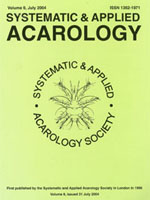The basic body structure of the Tenuipalpidae, or false spider, mites is discussed, along with morphological characters used for genus and species determination. The biology of these plant feeding mites is reviewed, including reproductive modes, dispersal and low chromosome number. The interactions of the false spider mites with their host plants and the damage they incur are considered, including the increasing economic importance of Brevipalpus spp. and of Raoiella indica Hirst. The associations of tenuipalpids with plant diseases, caused by bacteria, fungi and especially viruses, are discussed. Methods to reduce tenuipalpid damage are reviewed, including sampling and monitoring in the field, quarantine efforts and horticultural, chemical and biological control means. Lists of natural enemies are appended, and the scarcity of specific natural enemies of the Tenuipalpidae is noted. The postulated modes that these mites employ to elude their predators are discussed. Finally, suggestions for further research are outlined. These include exploration for false spider mites and their natural enemies in relatively little-surveyed regions, studies on the biology of additional pest species and on their toxins, studying the interactions between mites, hosts and plant diseases, and the various modes of sex determination and parthenogenesis in false spider mites, with emphasis on Brevipalpus spp. and their cryptic, possibly host-associated biotypes.
How to translate text using browser tools
1 June 2008
The Tenuipalpidae: An under-explored family of plant-feeding mites
Uri Gerson
ACCESS THE FULL ARTICLE

Systematic and Applied Acarology
Vol. 13 • No. 2
June 2008
Vol. 13 • No. 2
June 2008
biological control
Brevipalpus
false spider mites
natural enemies
Tenuipalpidae




